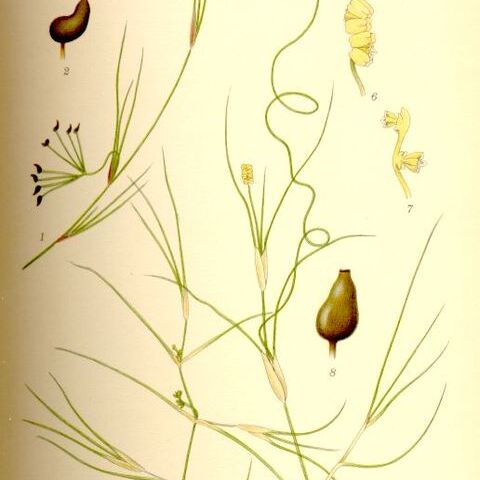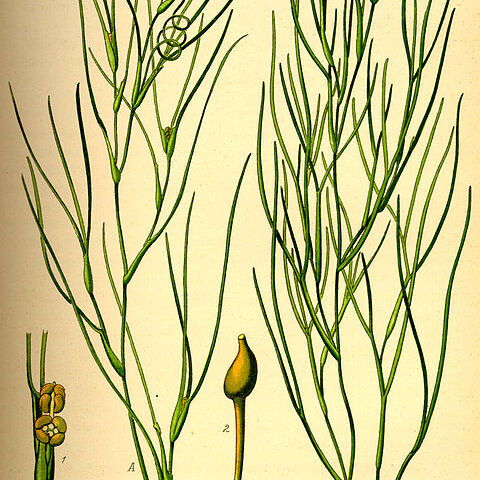Perennial or annual, submerged aquatic herb with elongate rhizomes; turions present or absent; stems erect, elongated or very short. Leaves with narrow-linear blade and entire or notched apex; sheath loose, nonligulate, auriculate. Inflorescence (1 or) 2-flowered, emerging from 2 spathal leaves; peduncle elongating and the spike emerging either just above the leaves (submerged-flowering species) or to the surface (surface-flowering species). In surface-flowering species the peduncle becomes loosely to tightly coiled, retracting flowers below surface as carpels mature. Perianth absent. Carpels 2–19 (–26), free, 1-locular, initially sessile or subsessile but stipe elongating after pollination in most species; ovule 1. Drupelets ±asymmetric, each on a stipe that sometimes becomes reflexed, usually falling with stipe still attached, the spongy exocarp decaying to leave a hard black or brown endocarp with a stylar beak and a subapical depression.
Plants perennial or annual, in saline, brackish, or extremely hard water, totally submerged. Rhizomes slender, usually branched. Stems terete, elongated or not. Leaves alternate, sessile, narrowly linear, entire or minutely denticulate toward apex; stipules adnate to leaf base and sheathing stems; sheaths shortly auriculate, ligule absent. Inflorescences of few-flowered spikes, pedunculate; spikes enclosed by involucral leaves at first; peduncles short at first but elongated in fruit. Flowers hermaphroditic, small, ebracteate. Perianth absent. Stamens 2; anthers sessile, extrorse, opening by longitudinal slits. Carpels 4 or more, free, 1-ovuled, sessile in flower but usually becoming narrowly stipitate in fruit; stigma sessile, peltate or umbonate. Fruit drupaceous, asymmetric, indehiscent. Seeds without endosperm.
Herbs, annual or rarely perennial, not rhizomatous, caulescent; turions absent [present]. Leaves alternate to subopposite, submersed, sessile; sheath not persisting longer than blade, not leaving circular scar when shed, not ligulate, not auriculate; blade linear; intravaginal squamules scales, 2. Inflorescences terminal, capitate spikes, with subtending spathe, pedunculate; peduncle following fertilization often elongating, often spiraling. Flowers bisexual; subtending bracts absent; perianth absent; stamens 2, in 1 series; anthers distinct, dehiscing longitudinally; pollen arcuate; pistils 4--16, distinct, stipitate; ovules parietal, campylotropous. Fruits drupaceous. Seeds 1; embryo straight.
Flowers hermaphrodite, small, in terminal spikes at first enclosed by the sheathing base of the leaves, at length much elongated; bracts and perianth absent
Stamens 2; filaments short, broad; anthers extrorse, loculi reniform and separated by the connective
Leaves opposite or alternate, linear or setaceous, sheathing at the base
Fruits long-stipitate with spirally twisted stalks, indehiscent
Carpels 4 or more, free, stigmas peltate or umbonate
Seeds pendulous, without endosperm
Aquatic herbs of saline marshes
Ovule solitary, pendulous


